Application notes
Vol.7 Innovative biomarker discovery by combination of new RNA extraction reagent with high-sensitive DNA chip
Features of new RNA extraction reagent
3D-Gene®RNA extraction reagent from liquid sample kit
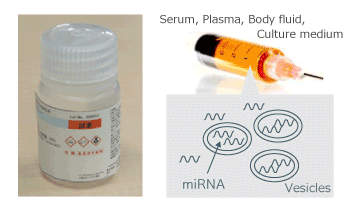
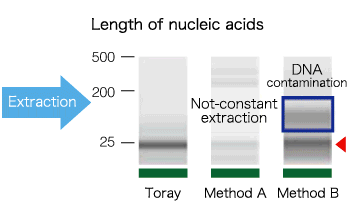
- Extraction efficiency is stable between samples
- Extract RNA without DNA contamination that influence microarray data
Features of high-sensitive DNA chip, 3D-Gene®
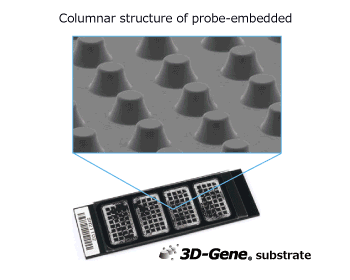
Achievement of higher sensitivity, reproducibility and accuracy compared with traditional DNA chips
- Low noise achieved by black resin substrate and columnar structure of probe-embedded area
- Immobilization of Oligo DNA probes with high density by surface modification with nano-technology
- Enhanced hybridization efficiency by Micro-beads agitation.
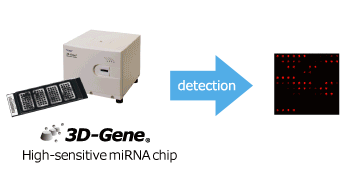
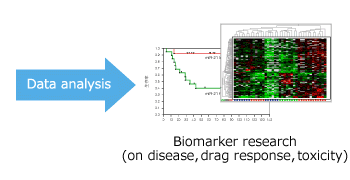
- High-sensitive DNA chip enable to detect miRNAs from 300uL of body fluid samples
- Enable to analyse comprehensive miRNAs at the same time (about 1700 miRNAs for human)
- The data is highly quantitative and highly reproducible
- About 800 miRNAs can be detectable from human blood samples
The combination of Toray’s reagent and chip enables high-sensitive detection
Various biomarker research with serum/plasma miRNAs
mir-125b can be a biomarker for drug resistance in breast cancer!
Circulating MiR-125b as a Marker Predicting Chemoresistance in Breast Cancer
Hongjiang Wang*, Guang Tan, Lei Dong, Lei Cheng, Kejun Li, Zhongyu Wang, Haifeng Luo
PlosOne April 2012 | Volume 7 | Issue 4 | e34210
| Background | It is very important to predict drug-resistance before starting chemotherapy against cancer in order to prevent recurrence and metastasis. To predict the treatment outcome from chemotherapy, authors evaluated whether expression of circulating miRNAs in serum can predict clinical outcome in breast cancer patients. |
|---|---|
| Method | Before chemotherapy, miRNA level in serum from 56 patience was measured. After surgery, proliferating cell nuclear antigen (PCNA) immunostaining and TUNEL were performed in surgical samples to determine the effects of chemotherapy on cancer cell proliferation and apoptosis, respectively. |
| Result | First of all, authors were focused 4 miRNAs (miR-10b, miR-34a, miR-125b, miR-155) that were highly correlated with progression of cancer stages. Then they identified miR-125b that shows a highly inverse correlation with index of drug resistance. Additionally, they confirm in vitro that miR-125b was highly correlated with drug-resistance in cancer cells. Furthermore, it was revealed that the E2F3 gene was one of the targets of miR-125b. |
| Conclusion | These data suggest that circulating miR-125b expression is associated with chemotherapeutic resistance of breast cancer, and it can be a biomarker for it. Additionally, the miR-125b was considered to be the possible target for new anticancer drugs. |
miRNAs in serum can be biomarker candidates of Alzheimer’s disease
Blood serum miRNA: Non-invasive biomarkers for Alzheimer's disease. Hirosha Geekiyanage, Gregory A. Jicha , Peter T. Nelson , Christina Chan, Experimental Neurology 235 (2012) 491-496
| Background | There is a need to identify non-invasive biomarkers for the detection of sporadic Alzheimer's disease (AD). |
|---|---|
| Method | Authors previously studied microRNAs (miRNAs) in AD autopsy brain samples and reported a connection between miR-137, -181c, -9, -29a/b and AD, through the regulation of ceramides. In this study, authors measured those miRNAs level in 7 serum samples from both probable AD patients and healthy donors. Then they evaluated those miRNAs in mouse serum by using AD risk factor model (high dietary fat intake). |
| Result | Authors identified that these miRNAs were down-regulated in the blood serum of probable AD patients. The levels of these miRNAs were also reduced in the serum of AD risk factor models. Especially miR-137, -181c, -9 were drastically downregulated. Furthermore, expression of those candidate miRNAs was different between sexes. |
| Conclusion | The findings suggest a potential use for circulating miRNAs as non-invasive and relatively inexpensive biomarkers for the early diagnosis of AD. |
<Other References using microarray>
Detection of gastric cancer-associated microRNAs on microRNA microarray comparing pre- and post-operative plasma." Br J Cancer. 2012 Feb 14;106(4):740-7."Plasma microRNAs as novel biomarkers for early detection of lung cancer" Int J Clin Exp Pathol 2011;4(6):575-586 "Clinical Impact of Down-Regulated Plasma miR-92a Levels in Non-Hodgkin’s Lymphoma" PLoS One. 2011 Feb 24;6(2):e16408.

